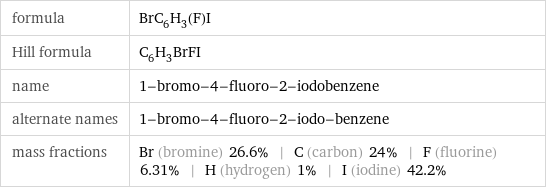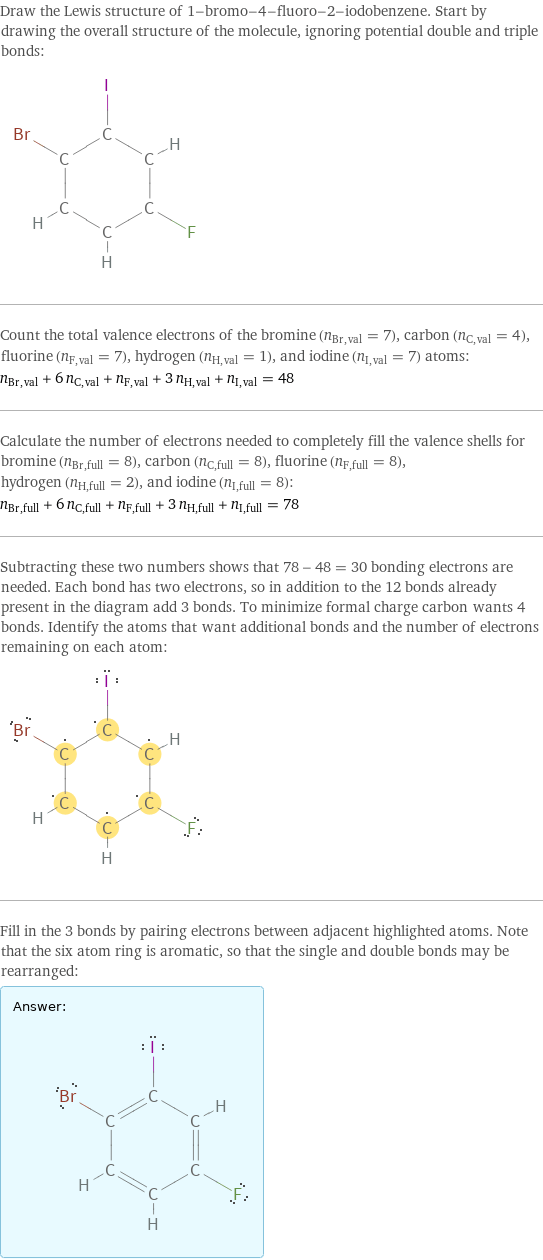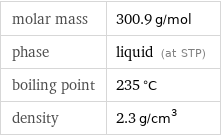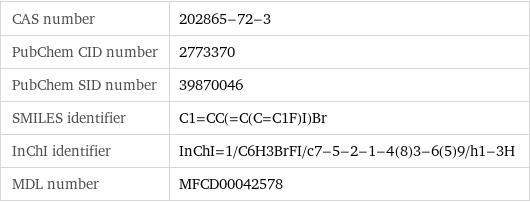Input interpretation

1-bromo-4-fluoro-2-iodobenzene
Chemical names and formulas

formula | BrC_6H_3(F)I Hill formula | C_6H_3BrFI name | 1-bromo-4-fluoro-2-iodobenzene alternate names | 1-bromo-4-fluoro-2-iodo-benzene mass fractions | Br (bromine) 26.6% | C (carbon) 24% | F (fluorine) 6.31% | H (hydrogen) 1% | I (iodine) 42.2%
Lewis structure

Draw the Lewis structure of 1-bromo-4-fluoro-2-iodobenzene. Start by drawing the overall structure of the molecule, ignoring potential double and triple bonds: Count the total valence electrons of the bromine (n_Br, val = 7), carbon (n_C, val = 4), fluorine (n_F, val = 7), hydrogen (n_H, val = 1), and iodine (n_I, val = 7) atoms: n_Br, val + 6 n_C, val + n_F, val + 3 n_H, val + n_I, val = 48 Calculate the number of electrons needed to completely fill the valence shells for bromine (n_Br, full = 8), carbon (n_C, full = 8), fluorine (n_F, full = 8), hydrogen (n_H, full = 2), and iodine (n_I, full = 8): n_Br, full + 6 n_C, full + n_F, full + 3 n_H, full + n_I, full = 78 Subtracting these two numbers shows that 78 - 48 = 30 bonding electrons are needed. Each bond has two electrons, so in addition to the 12 bonds already present in the diagram add 3 bonds. To minimize formal charge carbon wants 4 bonds. Identify the atoms that want additional bonds and the number of electrons remaining on each atom: Fill in the 3 bonds by pairing electrons between adjacent highlighted atoms. Note that the six atom ring is aromatic, so that the single and double bonds may be rearranged: Answer: | |
3D structure

3D structure
Basic properties

molar mass | 300.9 g/mol phase | liquid (at STP) boiling point | 235 °C density | 2.3 g/cm^3
Units

Liquid properties (at STP)

density | 2.3 g/cm^3 refractive index | 1.63
Units

Chemical identifiers

CAS number | 202865-72-3 PubChem CID number | 2773370 PubChem SID number | 39870046 SMILES identifier | C1=CC(=C(C=C1F)I)Br InChI identifier | InChI=1/C6H3BrFI/c7-5-2-1-4(8)3-6(5)9/h1-3H MDL number | MFCD00042578
Safety properties

flash point | 110 °C